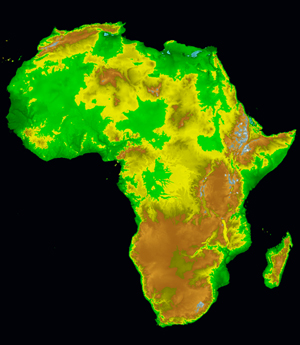
Lake Victoria, located on the equator between the two main branches of the East African Rift Valley system, is well situated to record large-scale climate events that affected not only tropical Africa but also the polar regions. About 90% of the lake's water arrives and exits through the atmosphere, making it extremely sensitive to changes in rainfall:evaporation balance. Sediment cores from this enormous lake (ca. 69,000 km2) are rich in the remains of diatoms, single-celled algae with siliceous "shells," making them valuable archives of lacustrine conditions that in turn yield useful insights into past climate changes.
Global cooling was usually associated with aridity in tropical Africa during the late Quaternary. A dense paleosol underlies soft organic sediments across the entire lake basin, showing that Lake Victoria dried out shortly after the Last Glacial Maximum, ca. 15,000 calendar years ago, and perhaps ca. 18-17,000 BP as well.

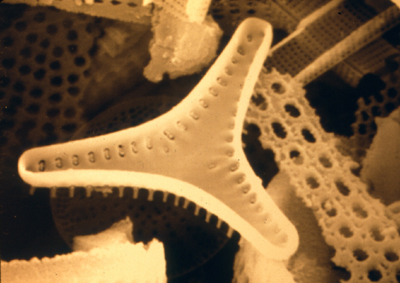
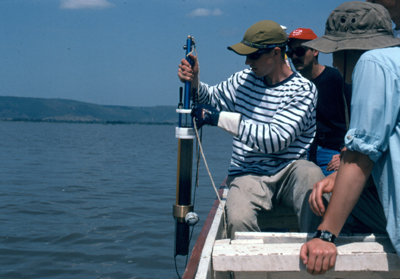
Warm-Wet Cool-Dry Reversal
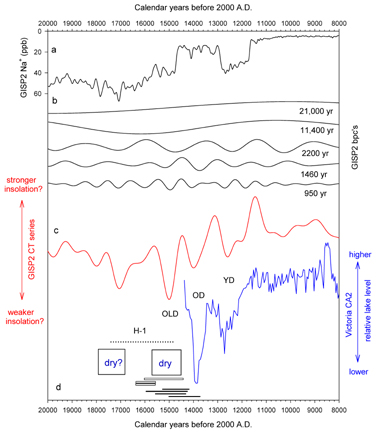
Victoria's modern endemic cichlid fish fauna evolved in a remarkably short time from ancestors that survived the drought elsewhere. A likely cause of the desiccation derives from a compilation of band pass components from the GISP2 record that are thought to reflect precession-influenced insolation and solar variability. The resultant composite curve suggests that severe cooling events related to global-scale insolation changes may have caused the lake low stands by weakening monsoons and convective rainfall in the tropics.
East Africa was much wetter during the early Holocene than it is today. Following an abrupt transition ca. 8500-7500 BP that was also registered at both poles, rainfall was more seasonally restricted. Climates became drier on average after ca. 6000 BP, especially after 3000 BP. The long-term rainfall decline followed the waning July equatorial insolation curve and increased mid-Holocene seasonality reflects opposing insolation trends during the two equatorial rainy seasons.
Interestingly, the classic warm-wet, cool-dry association reversed during much of the last millennium. The Victoria basin was unusually arid during Europe's Medieval Warm Period and unusually wet during cool phases of the globally distributed "Little Ice Age." We don't know why, at present, but we suspect that solar variability effects on the Intertropical Convergence Zone were involved.
Equally surprising, temperature-rainfall associations reverted back to "normal" warm-wet/cool dry patterns during the Dalton sunspot minimum ca. 1800 AD, and observed levels of Lake Victoria rose during every sunspot peak of the 20th century. These findings may be significant for modern African societies, because rainfall peaks trigger mosquito-borne Rift Valley Fever outbreaks (RVF: see asterisks) as well as damaging floods and gully erosion. If the proposed link between sunspot peaks and equatorial African rainfall is real, then it may permit prediction of future wet periods several years in advance.
Care to bet that another rainfall maximum and RVF outbreak will occur during the next peak in the ca. 11-year sunspot cycle, some time around 2010 AD?
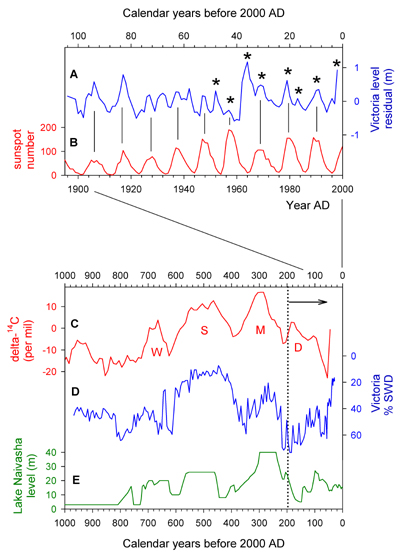
Selected References
Stager, J.C., D. Ryves, B.F. Cumming, L.D. Meeker, and J. Beer. 2005. Solar variability and the levels of Lake Victoria, East Africa, during the last millennium. Jour. Paleolimnol. 33:243-251.
Mayewski, P.A., Rohling, E., Stager, J.C., Karlen, W., Maasch, K.A., Meeker, L.D., Meyerson, E.A., Gasse, F., van Kreveld, S., Holmgren, K., Lee-Thorpe, J., Rosqvist, G., Rack, F., Staubwasser, M., Schneider, R.R., & Steig, E.J. 2004. Holocene climate variability. Quat. Res. 62: 243-255.
Stager, J.C., Day, J.J., & Santini, S. 2004. Comment on "Origin of the superflock of cichlid fishes from Lake Victoria, East Africa." Science 304: 963.
Stager, J.C., Cumming, B.F., & Meeker, L.D. 2003. A 10,000 year high-resolution diatom record from Pilkington Bay, Lake Victoria, East Africa. Quat. Res. 59: 172-181.
Stager, J.C., Mayewski, P.A., & Meeker, L.D. 2002. Cooling cycles, Heinrich events, and the desiccation of Lake Victoria. Palaeogeogr., Palaeoclim., Palaeoecol. 183:169-178.
Stager, J.C., & Mayewski, P.A.. 1997. Abrupt early to mid-Holocene climatic transition registered at the equator and the poles. Science 276:1834-1836.

